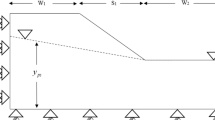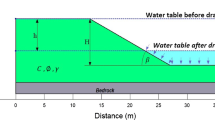Abstract
Normally, the edge effects of surficial landslides are not considered in the infinite slope method for surficial stability analysis of soil slopes. In this study, the limit stress state and discrimination equation of an infinite slope under saturated seepage flow were analyzed based on the Mohr-Coulomb strength criterion. Therefore, a novel failure mode involving three sliding zones (upper tension zone, middle shear sliding zone, and lower compression zone) was proposed. Accordingly, based on the limit equilibrium analysis, a semi-analytical framework considering the edge effect for the surficial stability of a soil slope under downslope seepage was established. Subsequently, the new failure mode was verified via a numerical finite element analysis based on the reduced strength theory with ABAQUS and some simplified methods using SLIDE software. The results obtained by the new failure mode agree well with those obtained by the numerical analysis and traditional simplified methods, and can be efficiently used to assess the surficial stability of soil slopes under rainwater seepage. Finally, an evaluation of the infinite slope method was performed using the semi-analytical method proposed in this study. The results show that the infinite slope tends to be conservative because the edge effect is neglected, particularly when the ratio of surficial slope length to depth is relatively small.
Similar content being viewed by others
References
Wang X, Ma C, Wang Y, Wang Y, Li M, Dai Z, Li M. Effect of root architecture on rainfall threshold for slope stability: Variabilities in saturated hydraulic conductivity and strength of root-soil composite. Landslides, 2020, 17(8): 1965–1977
Lee L M, Gofar N, Rahardjo H. A simple model for preliminary evaluation of rainfall-induced slope instability. Engineering Geology, 2009, 108(3–4): 272–285
Si A, Zhang J, Zhang Y, Kazuva E, Dong Z, Bao Y, Rong G. Debris flow susceptibility assessment using the integrated random forest based steady-state infinite slope method: A case study in Changbai mountain, China. Water (Basel), 2020, 12(7): 2057
Urciuoli G, Pirone M, Picarelli L. Considerations on the mechanics of failure of the infinite slope. Computers and Geotechnics, 2019, 107(3): 68–79
Travis Q B, Houston S L, Marinho F A M, Schmeeckle M. Unsaturated infinite slope stability considering surface flux conditions. Journal of Geotechnical and Geoenvironmental Engineering, 2010, 136(7): 963–974
Simoni S, Zanotti F, Bertoldi G, Rigon G. Modelling the probability of occurrence of shallow landslides and channelized debris flows using GEOtop-FS. Hydrological Processes, 2008, 22(4): 532–545
Feng S, Liu H W, Ng C W. Dimensional analysis of pore-water pressure response in a vegetated infinite slope. Canadian Geotechnical Journal, 2019, 56(8): 1119–1133
Day R W. Design and repair for surficial slope failures. Practice Periodical on Structural Design and Construction, 1996, 1(3): 83–87
Montgomery D R, Dietrich W E. A physically based model for the topographic control on shallow landsliding. Water Resources Research, 1994, 30(4): 1153–1171
Haneberg W C. A rational probabilistic method for spatially distributed landslide hazard assessment. Environmental & Engineering Geoscience, 2004, 10(1): 27–43
Warburton J, Milledge D G, Johnson R. Assessment of shallow landslide activity following the January 2005 storm. In: Cumberland Geological Society proceedings. Northern Cumbria: Cumberland Geological Society, 2008, 7: 263–283
Griffiths D V, Huang J, Dewolfe G F. Numerical and analytical observations on long and infinite slopes. International Journal for Numerical and Analytical Methods in Geomechanics, 2011, 35(5): 569–585
Milledge D G, Griffiths D V, Lane S N, Warburton J. Limits on the validity of infinite length assumptions for modeling shallow landslides. Earth Surface Processes and Landforms, 2012, 37(11): 1158–1166
Zhuang X, Zhou S, Sheng M, Li G. On the hydraulic fracturing in naturally-layered porous media using the phase field method. Engineering Geology, 2020, 266: 105306
Zhou S, Zhuang X, Rabczuk T. Phase-field modeling of fluid-driven dynamic cracking in porous media. Computer Methods in Applied Mechanics and Engineering, 2019, 350: 169–198
Zhou S, Zhuang X, Rabczuk T. Phase field modeling of brittle compressive-shear fractures in rock-like materials: A new driving force and a hybrid formulation. Computer Methods in Applied Mechanics and Engineering, 2019, 355: 729–752
Zhou S, Rabczuk T, Zhuang X. Phase field modeling of quasi-static and dynamic crack propagation: COMSOL implementation and case studies. Advances in Engineering Software, 2018, 122: 31–49
Zhou S, Zhuang X, Rabczuk T. A phase-field modeling approach of fracture propagation in poroelastic media. Engineering Geology, 2018, 240: 189–203
Zhou S, Zhuang X, Zhu H, Rabczuk T. Phase field modelling of crack propagation, branching and coalescence in rocks. Theoretical and Applied Fracture Mechanics, 2018, 96: 174–192
Wiberg N E, Koponen M, Runesson K. Finite element analysis of progressive failure in long slopes. International Journal for Numerical and Analytical Methods in Geomechanics, 1990, 14(9): 599–612
Taylor D W. Fundamentals of Soil Mechanics. New York: Wiley, 1948
Day R W, Axten G W. Surficial stability of compacted clay slopes. Journal of Geotechnical Engineering, 1989, 115(4): 577–580
Pradel D, Raad G. Effect of permeability on surficial stability of homogeneous slopes. Journal of Geotechnical Engineering, 1993, 119(2): 315–332
Rosso R, Rulli M C, Vannucchi G. A physically based model for the hydrologic control on shallow landsliding. Water Resources Research, 2006, 42(6): 770–775
Lade P V. The mechanics of surficial failure in soil slopes. Engineering Geology, 2010, 114(1–2): 57–64
Wang L Z, Guo D J. Secondary stress analysis of slope tunnel. Mechanical Engineering, 2000, 22(4): 25–28 (in Chinese)
Li W H, Peng L M, Lei M F, An Y L. Secondary and primary stress distribution of terrain bias tunnel. Journal of Railway Science and Engineering, 2012, 9(4): 63–69 (in Chinese)
Gao X, Wang H N. Analytical solution of ground response induced by excavation of shallow-embedded bias tunnel under slope. Water Resources and Hydropower Engineering, 2019, 50(1): 1–9 (in Chinese)
Zhao L, Cheng X, Li L, Chen J, Zhang Y. Seismic displacement along a log-spiral failure surface with crack using rock Hoek-Brown failure criterion. Soil Dynamics and Earthquake Engineering, 2017, 99: 74–85
Fredlund D G, Rahardjo H. Soil Mechanics for Unsaturated Soils. New York: John Wiley & Sons Inc., 1993
Zheng Y, Zhao S, Li A, Tang X. FEM Limit Analysis and Its Application in Slope Engineering. Bejing: China Communication Press, 2011 (in Chinese)
Fellenius W. Calculation of the stability of earth dams. In: Transactions of the 2nd Congress on Large Dams. Washington D.C.: International Commission on Large Dams (ICOLD) Paris, 1936, 445–463
Ji J, Zhang W, Zhang F, Gao Y, Lu Q. Reliability analysis on permanent displacement of earth slopes using the simplified Bishop method. Computers and Geotechnics, 2020, 117(1): 103286
Janbu N. Stability Analysis of Slopes with Dimensionless Parameters. Cambridge: Harvard University, 1959
Acknowledgements
This research was supported by the Sichuan Science and Technology Program (No. 2019YJ0323) and the National Natural Science Foundation of China (Grant No. 42007247).
Author information
Authors and Affiliations
Corresponding author
Rights and permissions
About this article
Cite this article
Lian, J., Wu, J. Surficial stability analysis of soil slope under seepage based on a novel failure mode. Front. Struct. Civ. Eng. 15, 712–726 (2021). https://doi.org/10.1007/s11709-021-0729-5
Received:
Accepted:
Published:
Issue Date:
DOI: https://doi.org/10.1007/s11709-021-0729-5




